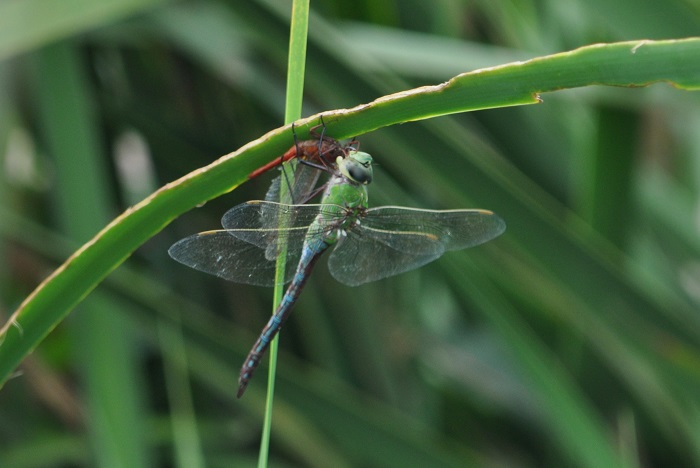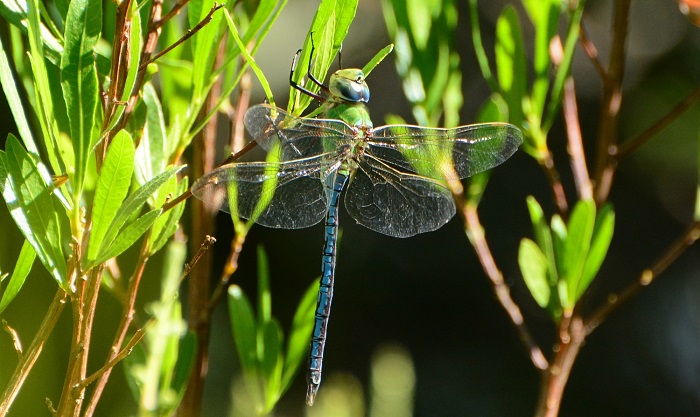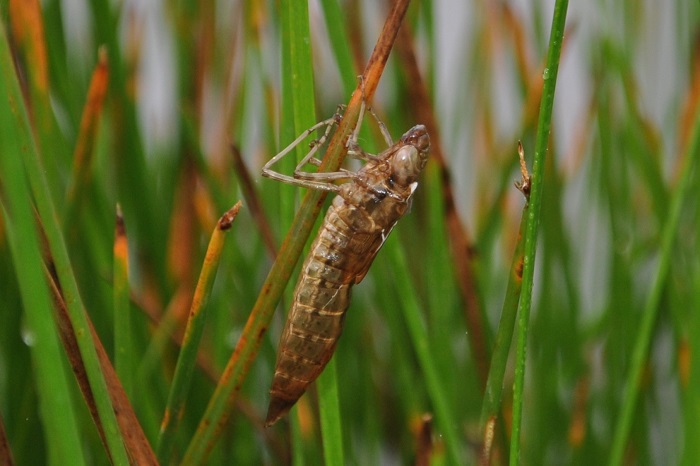Cover photo by Corrie du Toit.
Find the Blue Emperor in the FBIS database (Freshwater Biodiversity Information System) here.
Family Aeshnidae
Identification

Mabibi, iSimangaliso Wetland Park, KwaZulu-Natal
Photo by Ryan Tippett
Very large
Length up to 79mm; Wingspan attains 110mm.
Both sexes of the Blue Emperor are distinctive and unmistakable in Southern Africa. In males, the combination of large size, apple-green thorax, blue eyes, and blue abdomen is diagnostic. Females are similar but have dark brown and pale blueish-green, mottled abdomens and green eyes.
Click here for more details on identification.

Near Hluhluwe, KwaZulu-Natal
Photo by Ryan Tippett
Habitat

Photo by Ryan Tippett
The Blue Emperor inhabits a very wide range of habitat types and can be found virtually anywhere in South Africa. Anax imperator is a highly adaptable and successful species and will breed opportunistically at virtually any freshwater habitat, including cement reservoirs. It is most often seen near water and it has a preference for still habitats with plentiful water plants such as dams, ponds, marshes, pans, and slow-moving river stretches. The Blue Emperor is also regularly encountered far from water, even in very arid regions like the Karoo and the Kalahari. The Blue Emperor can quickly colonise seasonal wetlands after rain.

Photo by Alex Briggs
Behaviour
The Blue Emperor is a powerful and fast flyer and spends most of its time on the wing. At water, males tend to pick a general flight path that they follow back and forth, deviating only to chase down prey or a rival male. Females are most often seen when they visit the water to lay their eggs; otherwise, they are inconspicuous. When at rest, all Anax species hang vertically. The Blue Emperor is frequently active at dusk on humid evenings and regularly joins mixed-species feeding swarms at this time.

This species is an aggressive predator and often preys on other dragonflies. This one is feeding on a Broad Scarlet Crocothemis erythraea.
Near Hluhluwe, KwaZulu-Natal
Photo by Ryan Tippett
Status and Conservation
The Blue Emperor is a common, adaptable and widespread species. It has a high resistance to habitat degradation and can occur at virtually any water body, man-made or natural, including stagnant and somewhat polluted waters. It is listed as of Least Concern in the IUCN Red List of Threatened Species.

Near Wellington, Western Cape
Photo by Ryan Tippett
Distribution
The Blue Emperor has a vast distribution and is found virtually throughout Africa. It also occurs throughout most of Europe and Central Asia and south into parts of the Arabian peninsula and Southern India. The Blue Emperor is found across South Africa, including the arid regions.

Lake Naverone, KwaZulu-Natal
Photo by Ryan Tippett
The map below shows the distribution of records for Anax imperator in the OdonataMAP database, as at January 2020.

The map below shows the distribution of records for Anax imperator in the OdonataMAP database, as of December 2024.

Use this link to embed this map of distribution records in OdonataMAP: http://thebdi.org/wp-content/uploads/2020/01/664140-Blue-Emperor-actual-records.png
The map below is an imputed map, produced by an interpolation algorithm, which attempts to generate a full distribution map from the partial information in the map above. This map will be improved by the submission of records to the OdonataMAP section of the Virtual Museum. Use this link to embed the imputed distribution map: http://thebdi.org/wp-content/uploads/2020/01/664140-Blue-Emperor-inner-core-outer-core-and-periphery.png

The map below shows the imputed distribution which has been adjusted for terrain roughness


Phenology



Feeding on a Lucia Widow Palpopleura lucia.
Ehlatini Bush Camp, KwaZulu-Natal
Photo by Ryan Tippett
Further Resources
The use of photographs by Christian Fry and Corrie du Toit is acknowledged. All other photographs by Ryan Tippett.
Blue Emperor Anax imperator Leach, 1815
Other common names: Bloukeiser (Afrikaans)
Recommended citation format: Loftie-Eaton M; Navarro R; Tippett RM; Underhill L. 2025. Blue Emperor Anax imperator. Biodiversity and Development Institute. Available online at https://thebdi.org/2020/01/30/blue-emperor-anax-imperator/
References: Tarboton, M; Tarboton, W. (2019). A Guide to the Dragonflies & Damselflies of South Africa. Struik Nature.
Samways, MJ. (2008). Dragonflies and Damselflies of South Africa. Pensoft
Samways, MJ. (2016). Manual of Freshwater Assessment for South Africa: Dragonfly Biotic Index. Suricata 2. South African National Biodiversity Institute, Pretoria
Martens, A; Suhling, F. (2007). Dragonflies and Damselflies of Namibia. Gamsberg Macmillan.

Carnarvon district, Northern Cape
Photo by Ryan Tippett


